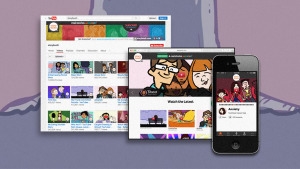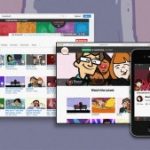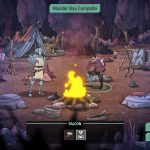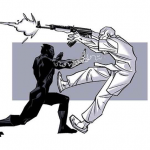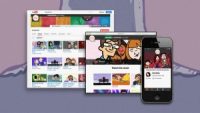These Kid-Made Cartoons Tackle Periods, Bullying, And Coming Out
“Embarrassing Period Story” is a three-minute animated cartoon told from the perspective of a 14-year-old girl named Oishani, who relates the shock, embarrassment, and anger she experienced when a boy she once liked discovered that she was on her period during a long school trip.
“He starts scavenging through my bag and picks up my pads and he’s like, ‘What’s this?’” Oishani narrates, as the boy on screen holds a handful of maxi-pads aloft for others to notice. “I snatch it from him, I feel like slapping it on him,” she adds. And then, because this is Cartoon Land, that leads to a funny re-imagining of what such a make-believe scene might have actually looked like.
In the end, a teacher busts the miscreant and Oishani moves on with her life. But what makes this different from traditional kid-friendly fodder is that Oishani is actually a real person. She uploaded her story in her own words semi-anonymously via audio file to a new kind of online cartoon network, Storybooth, which allows kids to share their first name, age, and whatever sort of serious, embarrassing or funny experience they’ve had to heal and help others relate.
Many of the results become cartoons, a stylization that not only lets the company add some visual humor or metaphorical exaggeration when things get heavy, but also helps protect the identity of the storyteller.
Whatever the outcome, people are watching. Since being posted on YouTube a little over a year ago, Oishani’s video has been viewed more than 2.1 million times, drawing 2,900 mostly supportive comments. The site, which launched last May, features about 70 tales with over 70 million total views. These run the gamut from how it feels be bullied for wearing a hijab (Ammaarah, age 16), to coping with parental pressure (Andrea, age 18). Other episodes talk about battling things like smoking, an eating disorder, and the fear and anxiety of coming out.
Growing up has always been tough; it’s arguable more so when the popularity contests or bullying can extend online. In many ways, Storybooth, offers a way to address all that. “The networks weren’t really keeping up with where [young people] were going in terms of how they consume digital content, and they weren’t really covering the issues that are relevant to kids in a meaningful way,” says Marcy Sinel, who cofounded the company with her husband Josh.
The Sinels learned that firsthand: They spent nearly two decades running an interactive agency that either built or managed some of the biggest kid-related communities online, including offerings from AOL, MTV, Noggin, and Nickelodeon. “Because YouTube is so authentic we didn’t want to script something,” she says of their new process. “We wanted to actually create a space where [these] voices were the platform. And we simply would take these stories and just elevate them through the animation.”
By launching online and crowdsourcing content, Storybooth not only stays relevant, but makes episodes (all are free) available on-demand to those who may need them. Many short cartoons are crossposted on YouTube directly to be found more easily. That could lead to some trolling, so the platform has its own curated comments section—users must log-in to share thoughts—for viewers to interact, offering camaraderie and support.
In general, every episode clocks in at around three minutes. Initially, the confessionals can be any length, but Storybooth edits keep thing moving and ensure they fit that attention-keeping timeframe. The group gives very little other advice or direction: Why complicate the honest process of unburdening? Before production and animation begins the site has a backchannel process to reach parents and secure a release form.
The team is coy about what exactly gets chosen and why but isn’t against covering a topic more than once—everyone’s story turns out a little different—or posting episodes that are counterintuitive. “Instagram Bullies Busted,” for instance, is from the perspective a teen who did the bullying and had to deal with the fallout. The team has an in-house producer, director, and lead animator control main themes and storyboarding, and contracts with a separate studio for more support.
For storytellers, the entire process works like a symbolic act. Despite what everyone else may be saying at school, within their social circle or elsewhere online, Storybooth is a portal to transform that negative into a positive. “Even with anonymity, for the young audience that idea of being creators… there’s some draw in that,” adds Josh, who notes that the diversity of voices and non-scripted honesty lends the whole venture a sort of authentic and expansive cast of characters, something traditional cable networks often struggle with as series drag on.
Many of the themes are obviously universal, which has kept traffic to older videos flowing steadily. Storybooth’s overall viewership is growing at a rate of 5% to 7% weekly, a feat the Sinels aided by enlisting over a half dozen different teen-centric YouTube stars to spin their own yarns as guest narrators.
The site’s audience is about 70% female. If the top-viewed videos are any indication, it’s quickly becoming a new way to tackle extremely sensitive issues. Among the five most watched episodes, “Embarrassing Period Story” ranks the highest, followed by stories about sexual abuse, mean mothering, and suicide. It’s not all dark: A recounting of the Bloody Mary seance is up there.
Storybooth monitors its discussion forums and will refer anyone who appears in need to a full spectrum mental health service like the Crisis Text Line, which has counselors ready to deal with most major issues in a way the mimics the immediacy and anonymity of message boards.
While the company won’t disclose financials, they’re backed by billionaire mutual fund manager Charles Royce. As with all social media platforms, the Sinels say they want to build audience and engagement first, and then decide how best to monetize through things like sponsorships or brand integrations. What’s on YouTube generates some money though front-reel ads, and at least one gaming company has sponsored content for a brought-to-you-by style name check.
So far, more than 38,000 people have bared their souls for potential cartoon treatment. Not everyone will get animated, but the Storybooth guarantees they’re all being listened to and hopes that just sharing provides some catharsis.
The Sinels aren’t totally surprised by all the buzz. Early on, their teenage daughter volunteered to share her own encounter with bullying and body-shaming. As they showed the cartoon to friends, people of all ages began talking about other experiences, too. “We knew then that we had something relatable,” Marcy says.
Storybooth let’s kids share their hard stories in their own words, to help themselves heal and help others through similar experiences.
“Embarrassing Period Story” is a three-minute animated cartoon told from the perspective of a 14-year-old girl named Oishani, who relates the shock, embarrassment and anger she experienced when an a boy she once liked discovered that she was on her period during a long school trip.
Fast Company , Read Full Story
(112)

